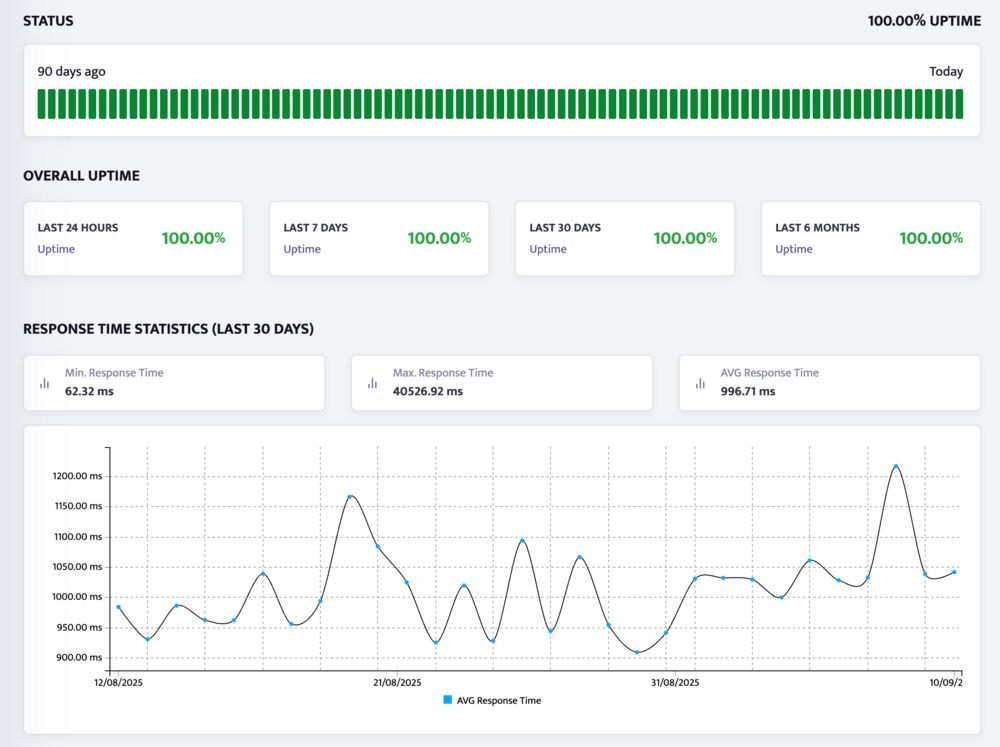Using Robotalp, a tool specialized in uptime monitoring, our team compiled and analyzed user data from 2024 and 2025. This allowed us to build a comprehensive dataset that reflects the uptime performance of servers, websites, and other digital assets. We gained valuable insights into server availability across various global locations, patterns of outages, and periods when disruptions were most frequent.
In this analysis, we explore the state of digital infrastructure using the extensive dataset we gathered through Robotalp, and we demonstrate through technical metrics why proactive monitoring is more critical than ever.
2025 Data: Noticeable Improvements in Uptime Performance
Annual Performance (January 1 – August 25, 2025)
- Organizations with zero downtime: 85%
- Organizations with only one outage: 1%
-
Organizations with multiple outages: 14%
These numbers show that only 15% of monitored organizations experienced any kind of downtime in 2025 a significant improvement over 2024.
Last 30 Days Uptime Overview:
- Total Downtime (Hours): 12,339.36
- Downtime Percentage: 5.53%
- Uptime Percentage: 94.47%
Based on organization-level data:
- 7% experienced downtime once
- 32% experienced multiple outages
-
61% had zero downtime
While the overall system stability looks promising, the fact that 39% of organizations still faced at least one outage underscores the ongoing need for continuous monitoring.)
2024 Data: High Traffic, High Risk
The year 2024 posed considerable challenges for digital infrastructure. Robotalp's data reveals that outages were widespread, and systems were often underprepared for high traffic scenarios:
- Total Outage Events: 4 million+
- Total Downtime: Over 1 million hours
- Total Requests Sent: 525 billion+ annually
- Longest Single Outage: 16 hours
- Slowest Response Time: 83.56 seconds
- Most Outage-Prone Day: November 28 (Black Friday)
Black Friday Crisis
The most disruptive day of 2024 was November 28, coinciding with Black Friday. This period of exceptionally high traffic puts immense strain on digital infrastructures. Even minor configuration errors or lack of scalability can trigger cascading failures. These findings emphasize the critical importance of load testing and persistent uptime monitoring for e-commerce and SaaS platforms.
Downtime doesn’t just translate into revenue loss it impacts brand reputation, customer retention, and SEO rankings as well.
)
Performance Metrics: It's About More Than Just Uptime
Average Uptime Rate
- 98.53% (2024): While seemingly high , mission-critical systems typically aim for 99.9% or higher.
Performance Score
- Average Score: 66%: While acceptable, most sites have room for optimization in terms of speed and responsiveness.
SEO Score
- 89%: Consistent uptime and stable performance are key factors in gaining visibility in search engines, marking your site as trustworthy.
)
Location & Notification Channels: Where and How Monitoring Happens
Server Location Data:
- 50.96% of demand originates from Europe, followed by North America and Southeast Asia.
- This underscores the importance of infrastructure distribution for global service providers.
Alert Channels
- 74.7% via Email – still the most used notification method.
-
Telegram (11.9%) and Slack (7.6%) – increasingly popular real time alert channels that reduce response time.
These stats highlight that monitoring is not just about detection but also about enabling fast and coordinated action through effective communication.
)
Why You Should Use an Uptime Monitoring Tool
Robotalp's data clearly shows that proactive monitoring empowers technical teams not only to observe system health but also to make strategic decisions.
- Predict and prevent failures before they escalate into major issues.
- Stress-test infrastructure ahead of high-traffic events like Black Friday.
- Improve internal coordination through consistent alerts and system logs.
-
Maintain transparency with clients via documented downtime for SLA reporting.
Ultimately, uptime monitoring tools are not just technical add-ons they are foundational to digital trust, operational continuity, and brand resilience.
Remember
A single outage doesn’t just stop systems; it can turn users away for good. That’s why proactive monitoring is the strongest insurance policy you can have for maintaining user trust.

